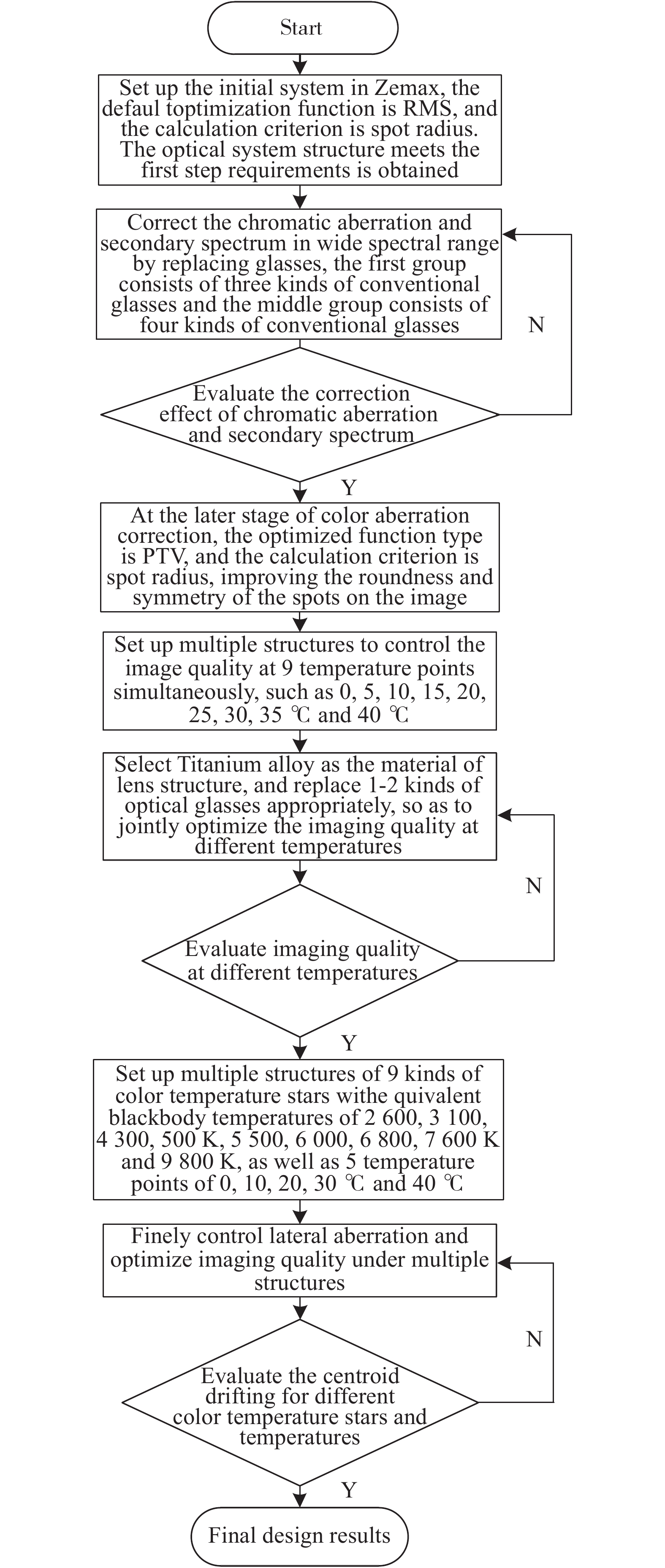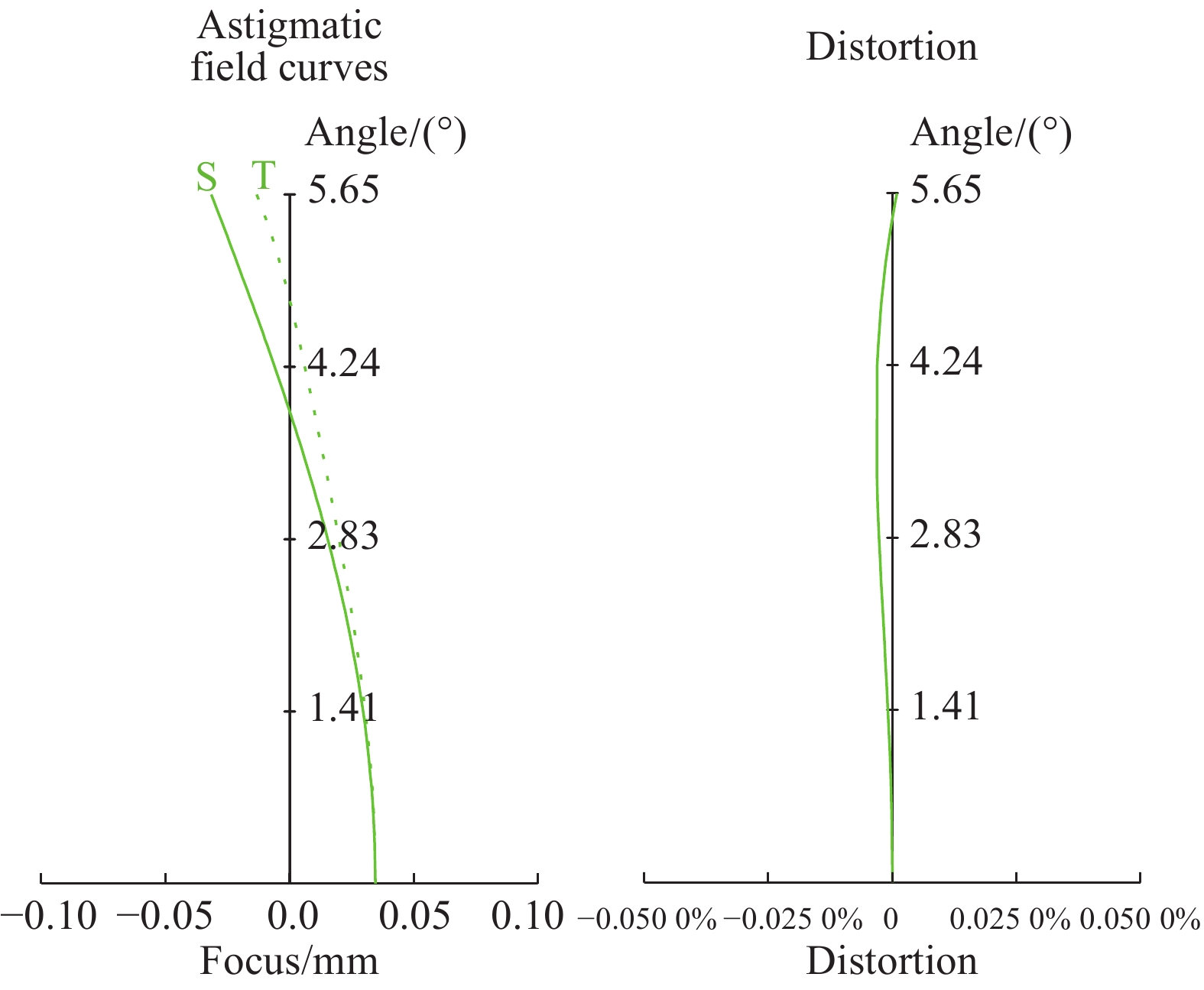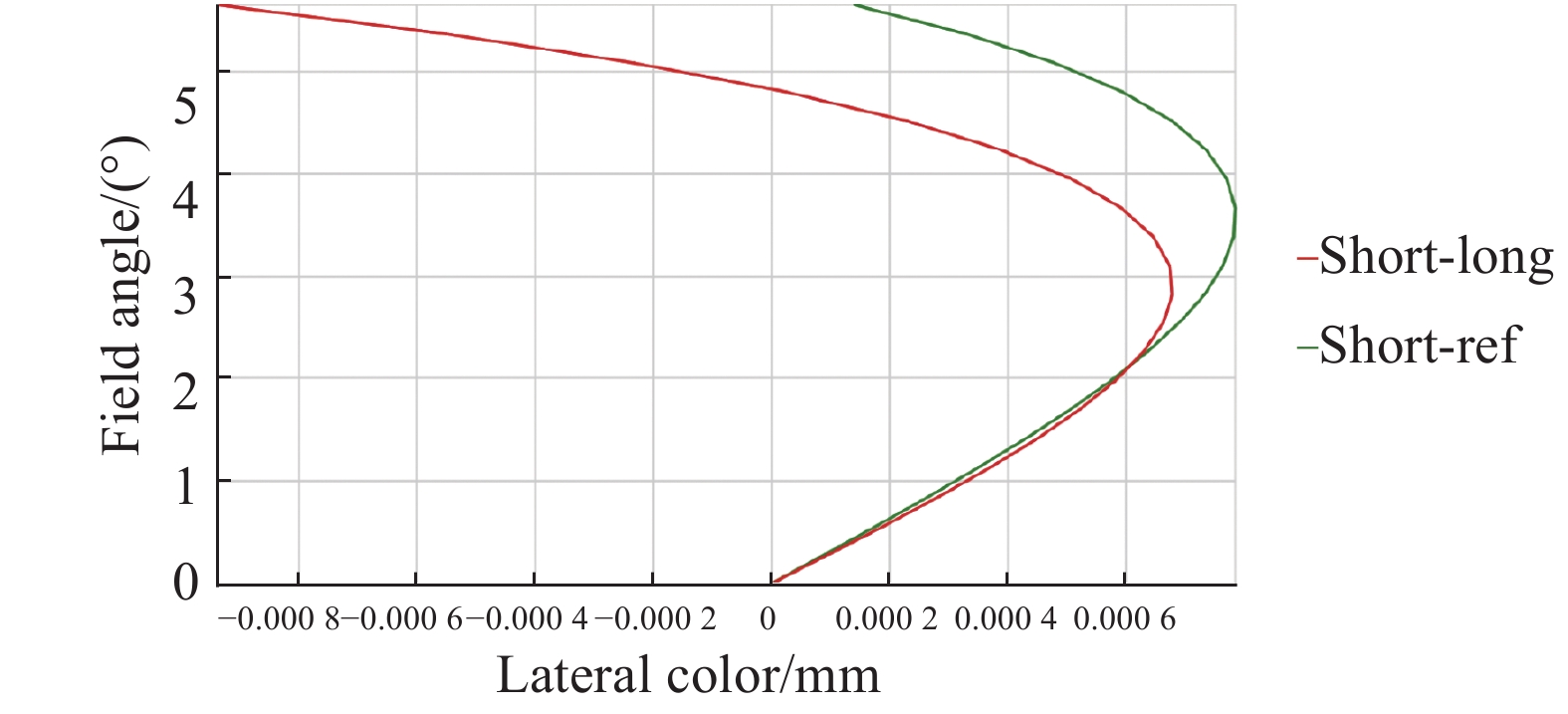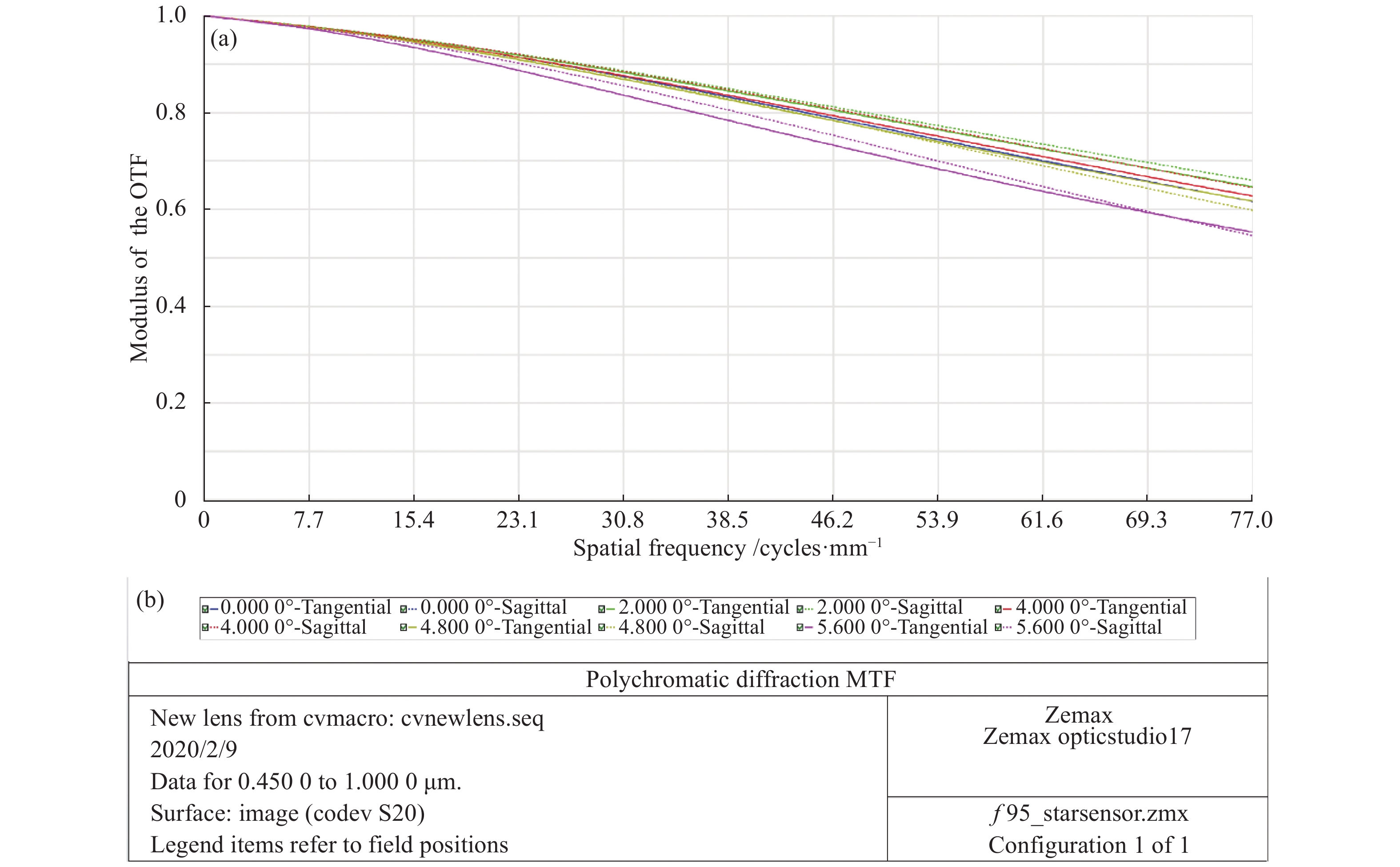-
星敏感器通过探测并识别出成像视场内天体恒星,识别后利用恒星位置精确已知的特征计算出飞行载体在惯性空间的三维姿态信息。由于具有测量精度高、精度不随时间发生漂移等优势,成为航天飞行器首要采用的姿态测量设备。
星敏感器设备主要由精密光学系统、探测器电子学以及软件算法等组成,光学系统是实现恒星光信号收集以及高精度姿态测量的核心组件。由于恒星光谱分布复杂以及航天工作环境恶劣,高精度星敏感器光学系统面临着比常规成像光学系统更多维度的设计难度与挑战。恒星具有不同色温,透射式光学系统由于倍率色差导致不同色温恒星的质心位置发生变化;星敏感器属于能量探测系统,识别并标定出不同色温恒星质心位置差异代价巨大。在航天应用环境,星敏感器光学系统可能受发射力学振动或冲击导致测量系统的内方位元素发生改变,从而引入测量误差;空间环境温度变化范围较大,导致光学系统焦距发生变化、焦面移动以及像差发生变化,从而产生测量误差。星敏感器光学系统的焦距、视场、探测口径以及探测光谱等指标直接影响着星敏感器的星等探测灵敏度、单星测量精度、姿态测量精度以及星图识别概率等核心指标,也是决定星敏感器体量的重要因素和轻小型化瓶颈技术。采用较长焦距、大相对孔径、较大视场、宽光谱范围、低畸变、无热化以及像方远心光路的光学系统技术有利于提高星敏感器测量精度、适应空间温度环境以及提升轻小型化性能。
在研究高精度星敏感器光学系统设计技术方面,国内外已有较多文献。在光学系统结构型式上主要有复杂化双高斯型[1-5]、远摄型[6-7]、Petzval型[8-9]或者折反射式光学系统[10]。在像差校正过程中引入非球面或衍射面校正高级球差或色差等[8-9,11],巩盾等人实现100 mm长焦距星敏感器光学系统设计[11],采用衍射面校正了470~830 nm宽谱段色差,但增加了光学元件制造难度。在光学系统性能评估方面,主要通过能量集中度、倍率色差以及畸变等进行评价[8,11-12];恒星色温或环境温度变化引起的质心位置变化未做深入研究分析及设计控制[13-14],这是光学系统限制星敏感器提升测量精度的主要误差来源,且后期难以通过标定技术校正。对于较长焦距星敏感器光学系统,同时实现宽谱段的色差校正以及大工作温度范围的无热化设计是十分困难的,甚至互为矛盾。
综上所述,目前针对长焦距宽谱段无热化星敏感器光学系统设计的研究较少。文中分析了色温恒星光谱分布特性,研究了不同色温恒星对透射式星敏感器光学系统测量精度的影响机理;通过建立色温恒星在设计谱段内的波长权重模型,确定了光学系统设计波长权重。提出采用质心漂移量评价色温恒星变化以及温度变化引起的质心精度变化,并对星敏感器后期难以标定校正的色温质心漂移量以及温度质心漂移量误差进行约束与控制。在此基础上,根据航天工程应用需求,设计了一款高精度的长焦距、宽谱段无热化星敏感器光学系统。通过光阑前置以及将探测光谱范围提升到450~1 000 nm的方式实现了光学系统最大程度的轻小型化设计;通过实现像方远心光路设计减少了光学系统受环境力学及温度变化产生的测量误差;基于常规玻璃材料实现了光学系统宽温度范围的无热化设计。最终实现星敏感器光学系统的色温质心漂移量以及温度质心漂移量误差不超过0.45 μm。设计结果表明光学系统成像质量优异,满足使用要求。
-
所研制星敏感器选用长光辰芯光电技术有限公司科学级探测器GSENSE2020BSI。探测器面阵规模为2 048×2 048,像素尺寸为6.5 μm×6.5 μm。光谱响应曲线如图1所示,探测器在可见光以及近红外谱段均具有较高量子效率,900 nm波长量子效率达到0.4以上。
星敏感器光学系统的主要设计指标包括焦距、探测视场、探测口径、光谱范围、畸变、远心度、能量集中度、质心漂移量以及工作温度范围等。选定探测器后,光学系统焦距决定了星敏感器像元分辨率,这是星敏感器实现单星测量精度的基础。探测口径与光谱范围共同影响星敏感器的探测星等;为了提高星敏感器恒星探测能力,充分利用GSENSE2020BSI探测器宽光谱高量子效率性能,成像光谱范围选择450~1 000 nm,有利于降低光学系统探测口径,最大程度实现轻小型化;挑战及难度是宽谱段的轴向色差及倍率色差校正。能量集中度、质心漂移量是星敏感器光学系统特殊性能指标。能量集中度满足恒星亚像元细分精度的核心需求,一般要求弥散斑在3×3 ~5×5 pixels。质心漂移量是衡量光学系统精度的重要指标,由彗差、畸变或倍率色差引起单一色温恒星、单一温度下的质心漂移量误差可以通过后期高精度星模拟器及转台标定而降低,由于恒星色温及温度变化引起的质心漂移量难以通过标定消除,需要通过光学设计进行控制。
综上,根据应用需求,确定光学系统主要设计指标如表1所示。
Parameters Values Focal length/mm 95±0.5 FOV/(°) ≥8×8 Pupil(F#) 2.4 Waveband range/nm 450−1 000 Energy concentration ≥85% in 3 ×3 pixels Centroid excursion/(″) ≤1.5 Distortion ≤0.05% Temperature/℃ 0-40 Table 1. Parameters of optical system design
-
天体恒星具有不同的色温,天文学家按照温度递减顺序表示为O、B、A、F、G、K、M等7个光谱型,每个光谱型细分为0~9个次例。恒星辐射出射度可表示为:
式中:λ为辐射波长,μm;
${{h}}$ 为普朗克常数,取$ 6.626\times {10}^{-34}$ J·s;c为光速,取$ 2.997\times {10}^{8}$ m/s;$ {k}_{\rm B} $ 为玻耳兹曼常数,取$ 1.38\times {10}^{-23}$ J/K;T为绝对温度,单位为K。当恒星色温发生变化时,恒星中心辐射波长会发生改变,不同色温恒星的中心辐射波长
$ {\lambda }_{p} $ 由维恩位移定律确定:对于A~M光谱型的恒星,色温范围为2 600~11 500 K,其中心辐射将波长在350~1 000 nm范围变化。由于透射式光学系统不可避免会产生色差,不同色温恒星光信号通过光学系统后质心位置将会发生变化。在设计时,需要确定不同色温恒星设计波长的权重,并以此进行设计或评价光学系统成像性能。CodeV或Zemax等光学设计软件采用离散波长和权重来表征光学系统光谱响应能力,假定离散波长数量共N个,谱段间隔为
$ \Delta {\rm{\lambda}} $ ,最大设计波长为$ {\lambda }_{\rm long} $ ,最小设计波长为$ {\lambda }_{\rm short} $ ,满足:式中:
$ {\lambda }_{\rm short} $ 取450 nm;$ {\lambda }_{\rm long} $ 取1 000 nm;N取11;光学设计选用离散波长为475、525、575、625、675、720、775、825、875、925、975 nm。每个离散波长的权重代表以该波长为中心、宽度Δλ光谱范围的辐射出射度总和,由下式确定:
K为常数因子,选择合适数值以确保
$ {W}_{T}\left({\lambda }_{i}\right) $ 权重在1~100范围之内。由于探测器在成像光谱范围内不同波长的量子效率存在差异,光学设计波长的权重分配应同时考虑色温恒星以及探测器量子效率的影响。波长λ到达探测器靶面处的有效辐射出射度为:
综合公式(4)、(5),得到光学系统设计时离散波长的权重计算模型为:
取不同色温恒星分别计算出光学系统设计与性能评估的离散波长权重值,温度选择2 600、3 100、4 300、5 000、5 500、6 000、6 800,7 600、9 800 K等典型温度。得到不同色温恒星的波长权重分布如表2所示。2 600~9 800 K范围内的色温恒星波长权重差异较大,表明星敏感器光学系统设计应对透镜材料引起的色差及二级光谱进行控制,在性能评价时需要分别按照对应色温下的波长权重进行分析。
Wavelength/nm Temperature/K 2 600 3 100 4 300 5 000 5 500 6 000 6 800 7 600 9 800 475 10 18 37 44 47 48 50 52 55 525 32 51 87 96 99 99 99 99 99 575 51 71 97 99 98 95 91 88 82 625 70 86 99 94 90 85 78 73 66 675 87 96 95 86 80 73 65 60 51 725 98 99 86 74 67 60 53 47 38 775 99 92 72 60 53 47 40 35 28 825 92 80 56 45 39 34 29 25 19 875 83 68 44 34 29 25 21 18 13 925 68 53 32 24 20 17 14 12 9 975 31 21 12 9 7 6 5 4 3 Table 2. Distribution values of wavelength weight with different temperature stars
-
光学传递函数能够客观评价星敏感器光学系统的成像质量,但无法准确评价光学系统设计精度性能。影响星敏感器光学系统精度的因素包括能量集中度、畸变以及导致光斑失对称分布的像差等;在外界环境不变的情况下,畸变、彗差以及倍率色差等校正到较小量后,采用星模拟器对星敏感器进行全视场多点标定及多项式拟合可以将质心测量误差校正。星敏感器面临探测目标光谱变化及工位环境温度变化的复杂性,光谱分布差异以及温度改变引起的像差变化会导致星敏感器光学系统弥散斑的质心位置发生变化。为了准确评估光学系统设计精度误差,采用质心漂移量进行评价更为客观量化。针对难以标定消除的星敏感器光学系统误差来源,恒星色温质心漂移量与温度变化质心漂移量是需要考虑并通过设计控制的。
工作环境温度为20 ℃时,等效黑体温度为5 500 K的恒星光信号通过光学系统后在像面的质心坐标为(xc5500,yc5500),其他色温恒星的质心位置(xcTB,ycTB)两者差值定义为恒星色温质心漂移量:
当工作环境温度发生变化时,取5 500 K色温恒星作为输入光信号,温度为T时质心位置(xcT,ycT)与20 ℃时质心位置的差值定义为温度变化质心漂移量:
根据要求,恒星色温质心漂移量以及温度变化质心漂移量设计要求如下:
(1)恒星色温质心漂移量。以等效黑体温度为2 600、3 100、4 300、5 000、5 500、6 000、6 800、7 600、9 800 K等9种色温恒星作为辐射输入,取475、525、575、625、675、720、775、825、875、925、975 nm等11 种离散波长按表2进行加权后,由于5 500 K色温恒星位于2 600~9 800 K色温恒星的中心温度位置,且所对应的G系光谱型色温恒星的数量最多,以5 500 K色温恒星为基准,在0、0.3、0.5、0.7、0.85、1 W等规一化视场下,其他色温恒星经过光学系统后弥散斑的能量重心与由该基准色温恒星弥散斑能量重心之间的偏差不大于0.5 μm。
(2)温度变化质心漂移量。0~40 ℃温度范围内,取475、525、575、625、675、720、775、825、875、925、975 nm等11种波长按5 500 K色温恒星进行加权,以20 ℃为基准,在0、0.3、0.5、0.7、0.85、1 W等规一化视场下,其他温度弥散斑能量重心与基准温度下弥散斑能量重心之间的偏差不超过0.75 μm。
-
传统星敏感器透射式光学系统结构型式主要包括复杂化双高斯、远摄型以及Petzval 3类,在球面透镜的基础上引入特殊色散光学玻璃材料、非球面以及衍射面等校正大相对孔径高级球差及宽谱段倍率色差。文中综合考虑以上光学系统结构型式校正像差的优势,摒弃不利于提高设计精度以及增加制造难度的设计元素,采用光阑前置的光学系统结构型式,将光阑设置在第一片透镜的第一个光学面上,如图2所示。光阑前置的方式有利于降低光学系统的体积与重量,实现轻小型化设计。当星敏感器镜头焦距较长及设计谱段较宽时,光学系统的色差及二级光谱较大,HFK61或CAF2等特殊色散玻璃能够校正长焦距及宽谱段下的色差,但这类玻璃的热膨胀系数大,温度改变后焦面发生较大偏离,成像质量下降。为了解决宽谱段的色差校正和无热化的设计矛盾,此设计前透镜组采用3种常规玻璃材料组合,中部透镜组采用4种常规玻璃组合的方式,联合优化校正宽谱段色差及二级光谱,并采用钛合金作为结构材料,实现了无热化成像要求,确保恒星色温质心漂移量与温度变化质心漂移量误差满足设计要求。像面前设置正光焦度透镜,实现近像方远心光路设计,降低光学系统受环境力学、温度变化引起的测量误差。光学系统采用全球面透镜设计,避免了采用复杂非球面或衍射面光学元件加工检测难度及成本高的问题。
-
采用Zemax光学软件进行设计与优化,主要设计流程与优化过程如下:
(1)基于设计指标要求与光学系统结构选型,在Zemax软件中输入符合设计要求的初始光学系统数据,包括焦距、视场、探测口径、透镜半径、厚度及材料等,初始优化时波长权重均设定为1;
(2)建立初始优化函数,基于Zemax默认的优化函数,选择类型为RMS、计算准则为Spot Radius,并控制光学系统的焦距、透镜中心厚度、边缘厚度、空气间隔、系统长度等参数,以透镜半径、厚度、空气间隔等为优化变量,开始初始阶段优化,优化过程中所有光学面保持为球面面型,通过控制光线在光学面的入射角较小,避免高级像差的产生,并重点校正轴上球差,获得像质初步满足要求的光学系统结构;
(3)此时色差尤其是倍率色差较大,通过替换光学玻璃材料的方式,在保持光学系统结构型式不变的情况下,前组采用3种常规玻璃材料组合以及中组采用4种常规玻璃组合的方式,联合校正宽谱段下的色差及二级光谱;为保证后期无热化优化效果,玻璃不选择HFK61、CaF2等线胀大的特殊色散玻璃。
(4)色差校正与优化的同时,逐步增加对畸变、像方远心等参数的控制,控制参量逐渐减小,避免因迭代步伐过大导致光学系统优化崩溃;
(5)色差校正与优化的后期,Zemax默认优化函数的选择类型改为PTV,计算准则为Spot Radius,提高像面弥散斑圆度及对称性;
(6)校正好宽谱段色差及二级光谱后,光学系统在常温下的像质满足要求,但温度变化后的像差未进行控制,利用Zemax多重结构方式,建立0、5、10、15、20、25、30、35、40 ℃等9个温度点的多重结构,对9个温度下的像质同时进行控制,镜筒结构件材料选择钛合金(线胀系数为9.5×10-6/K),优化时分析不同温度下的成像质量,并适当替换1~2种光学玻璃材料,最终获得宽温度范围下的优异成像质量;
(7)根据波长权重分配值,建立等效黑体温度为2 600、3 100、4 300、5 000、5 500、6 000、6 800、7 600以及9800 K等9种色温恒星,以及0、10、20、30、40 ℃等5个温度点的多重结构,考虑优化效率,温度控制点减少一半,共45个多重结构;
(8)评估不同色温恒星的质心漂移量以及不同温度下的质心漂移量设计结果,根据超差情况进行适当的微量优化调整,尤其是2 600 K色温恒星与9 800 K色温恒星的波长权重差异较大,需要精细控制倍率色差,调整优化过程中保持焦距、畸变、厚度、系统长度等参量复合设计指标要求;
(9)完成优化及评估,形成并输出光学系统设计报告。
优化流程的关键环节如图3所示。
-
光学系统经优化设计结果如表3所示,光路结构如图4所示。共8片球面透镜,后截距为10.3 mm,总长108 mm,各项设计结果均满足设计指标要求。光学系统实现了远心光路的设计,全视场的远心度优于0.8°,保证了探测视场内的照度均匀性。
Parameters Results Focal length/mm 94.932 1 FOV/(°) 8×8 Pupil(F#) 2.4 Waveband range/mm 450−1 000 Energy concentration ≥85% in 3×3 pixels Centroid excursion/(″) ≤1.0 Distortion ≤0.003 25% Temperature/℃ 0−40 Table 3. Results of optical system design
-
像散与畸变曲线设计如图5所示,全视场最大相对畸变不超过0.003 25%,引起主光线位置偏差不超过0.46″,测角误差较小,满足星敏感器高精度测量需求。倍率色差曲线如图6所示。在450 ~1 000 nm范围内,倍率色差不超过0.9 μm,获得了较完善校正,有利于降低恒星色温质心漂移量的误差。
-
MTF全面评估一般光学系统成像质量的综合指标。根据选用探测器像元为6.5 μm,计算出奈奎斯特频率为77 lp/mm,设计结果如图7所示,全视场的光学传递函数值MTF均优于0.55@77 lp/mm,成像质量优异。星敏感器通过细分算法实现亚像元质心定位精度,要求恒星光信号在探测器靶面形成3×3~5×5 pixels大小的弥散斑,通过能量集中度指标来评价星敏感器光学系统是否满足细分要求。设计结果如图8所示,满足3×3 pixels内弥散斑能量高于85%的成像质量要求。
-
此处重点分析后期难以通过高精度星模拟器标定校正的恒星色温变化质心漂移量以及温度变化质心漂移量两种误差,评估方法详见2.1节及2.2节。
-
以等效黑体温度5500 K的恒星为基准,计算2 600、3 100、4 300、5 000、6 000、6 800、7 600、9 800 K等8种色温恒星光信号经过光学系统后,在像面弥散斑的能量重心与由该基准色温恒星弥散斑能量重心之间的偏差,取0、0.3、0.5、0.7、0.85、1 W等5个规一化视场下,统计结果如表4及图9所示,恒星色温变化引起的质心漂移量均小于0.36 μm,对应的角度变化不超过0.78″。
Relative field 0 W 0.3 W 0.5 W 0.7 W 0.85 W 1.0 W Relative centroid drifting/μm 2 600 K 0 −0.038 4 −0.075 6 −0.152 9 0.089 6 0.268 4 3 100 K 0 −0.042 5 −0.068 7 0.317 5 0.207 8 −0.236 4 4 300 K 0 −0.034 6 −0.045 2 0.249 3 0.187 6 −0.197 8 5 000 K 0 −0.015 8 −0.027 2 0.132 1 0.096 2 0.105 8 5 500 K 0 0 0 0 0 0 6 000 K 0 0.008 4 0.009 6 −0.156 2 −0.126 5 −0.205 9 6 800 K 0 0.012 7 0.015 3 −0.184 4 −0.152 3 0.079 8 7 600 K 0 0.015 2 0.018 5 −0.232 1 −0.205 9 0.183 9 9 800 K 0 0.027 8 0.048 7 −0.355 4 −0.248 1 0.213 1 Table 4. Relative value of centroid drifting under change of star temperature (Unit: μm)
-
取5 500 K色温恒星为研究对象,以20 ℃下的质心位置为基准,评价0 、5 、10 、15 、25 、30 、35 ℃以及40 ℃温度下质心位置相对于基准位置的变化,以此评估星敏感器光学系统无热化设计效果。不同温度下相对于20 ℃的质心漂移量统计如表5所示,除以视场外温度变化引起的质心漂移量均小于0.45 μm,对应的角度变化不超过0.98″。
Temperature /℃ Relative field 0 W 0.3 W 0.5 W 0.7 W 0.85 W 1.0 W 0 0 −0.201 3 −0.286 4 −0.389 6 −0.254 1 −0.756 2 5 0 −0.089 5 −0.152 6 −0.256 8 −0.215 2 −0.198 3 10 0 −0.065 8 −0.095 6 −0.201 7 −0.195 8 −0.232 5 15 0 −0.023 1 −0.012 6 0.058 9 0.037 5 0.025 9 20 0 0 0 0 0 0 25 0 0.033 5 0.015 2 0.085 6 0.075 3 0.085 2 30 0 0.074 6 0.112 3 0.193 3 0.172 5 0.264 6 35 0 0.113 5 0.203 7 0.356 4 0.250 9 0.325 4 40 0 0.250 4 0.321 8 0.450 5 0.279 5 0.563 7 Table 5. Relative value of centroid drifting under change of temperature (Unit: μm)
以20 ℃焦距为基准,焦距随温度变化统计如表6所示。在0~40 ℃范围内,焦距变化值不超过2.7 μm,变化率小于0.003%。
Temperature /℃ 0 5 10 15 20 25 30 35 40 Focal length /mm 94.929 4 94.930 2 94.930 8 94.931 5 94.932 1 94.932 7 94.933 3 94.933 9 94.934 5 Difference /μm −2.7 −1.9 −1.3 −0.6 0 0.6 1.2 1.8 2.4 Table 6. Focal lengths and relative change under different temperatures
-
针对航天卫星自主导航星敏感器对高精度光学系统的需求,文中设计了一款长焦距无热化宽谱段星敏感器光学系统,实现了长焦距、中等视场、宽成像谱段、低畸变以及近远心光路等优点,镜头焦距95 mm,视场角8°×8°,相对孔径F/2.4,成像光谱范围覆盖450~1 000 nm,畸变优于0.00 325%。在研究方法上,研究了恒星色温及温度变化引起光学系统测量精度变化的机理,建立了基于恒星色温及探测器光谱响应能力的设计波长权重分配模型;识别并提出采用恒星色温变化质心漂移量以及温度变化质心漂移量评价星敏感器光学系统的精度设计结果,这是星敏感器整机后期难以通过标定技术消除的误差。在光学系统设计方面,采用光阑前置的光学系统结构型式,选择多组常规玻璃组合校正长焦距超宽谱段轴向色差及倍率色差,实现探测光谱宽度从300 nm提升到550 nm,全视场倍率色差不超过0.9 μm,降低了光学系统体积与重量,有利于星敏感器轻小型化。镜头设计与研制结果表明,光学系统在等效黑体温度为2 600~9 800 K色温恒星范围内的全视场质心漂移量不超过0.36 μm,0~40 ℃范围全视场质心漂移量不超过0.45 μm,镜头成像质量良好,满足航天卫星高精度星敏感器应用需求。
Optical system design of star sensor with long focal length and athermalization
doi: 10.3788/IRLA20200061
- Received Date: 2020-03-01
- Rev Recd Date: 2020-04-20
- Available Online: 2020-09-22
- Publish Date: 2020-09-22
-
Key words:
- star sensor /
- athermalization /
- optical design /
- long focal length /
- centroid drifting
Abstract: Optical system is the core component of autonomous navigation star sensor to realize the collection of star light and high-precision attitude measurement. In this paper, the optical system of high precision star sensor was taken as the research object, the influence mechanism of the accuracy of optical system for detecting different color temperature stars were studied and analyzed. It is difficult to suppress the centroid drift caused by the changes of star color temperature and ambient temperature through later calibration, which needs to be controlled under the stage of optical design. The calculation model and allocation method of optical system design wavelength weight were established, and the performance evaluation was carried out. In addition to the conventional energy concentration, distortion and asymmetric aberrations, the centroid drift of star color temperature and ambient temperature change were proposed as the main index of accuracy evaluation. According to the application requirements, a long focal star sensor optical system based on space satellite platform was designed, with the focal length of 95 mm, the relative aperture of f 2.4, the field view of 8°× 8°, the spectrum range of 450-1 000 nm, and the energy concentration of more than 85% in 3×3 pixels. Based on the regular glass materials, the lateral color aberration of the optical system was corrected under ultra-wide spectral range and long focal. The lateral color aberration of the full field was less than 0.9 μm; The results of accuracy analysis show that the accuracy of centroid position is less than 0.36 μm in the range of 2 600-9800 K, and the change of focal length is less than 2.7 μm in the range of 0-40℃, and the accuracy of centroid position caused by temperature is less than 0.45 μm.






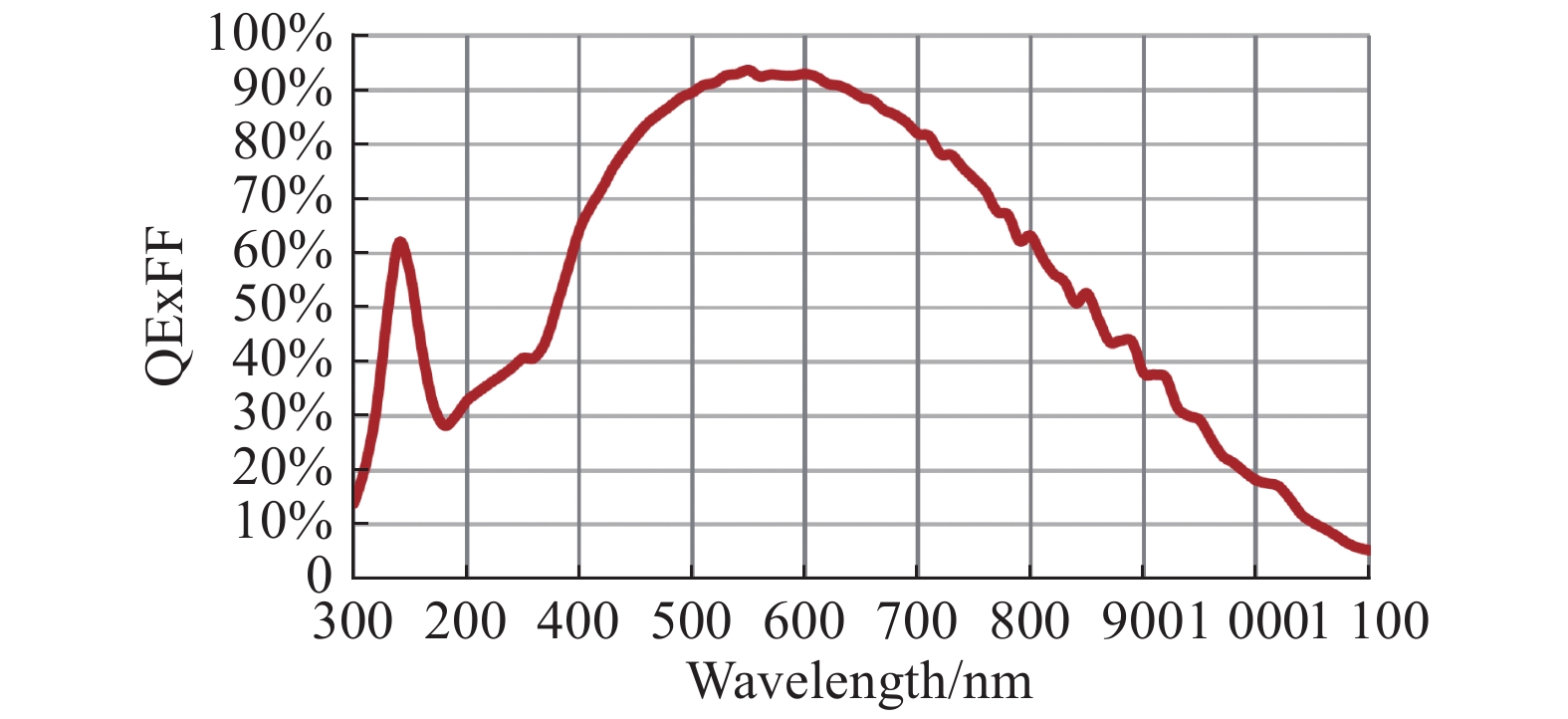

















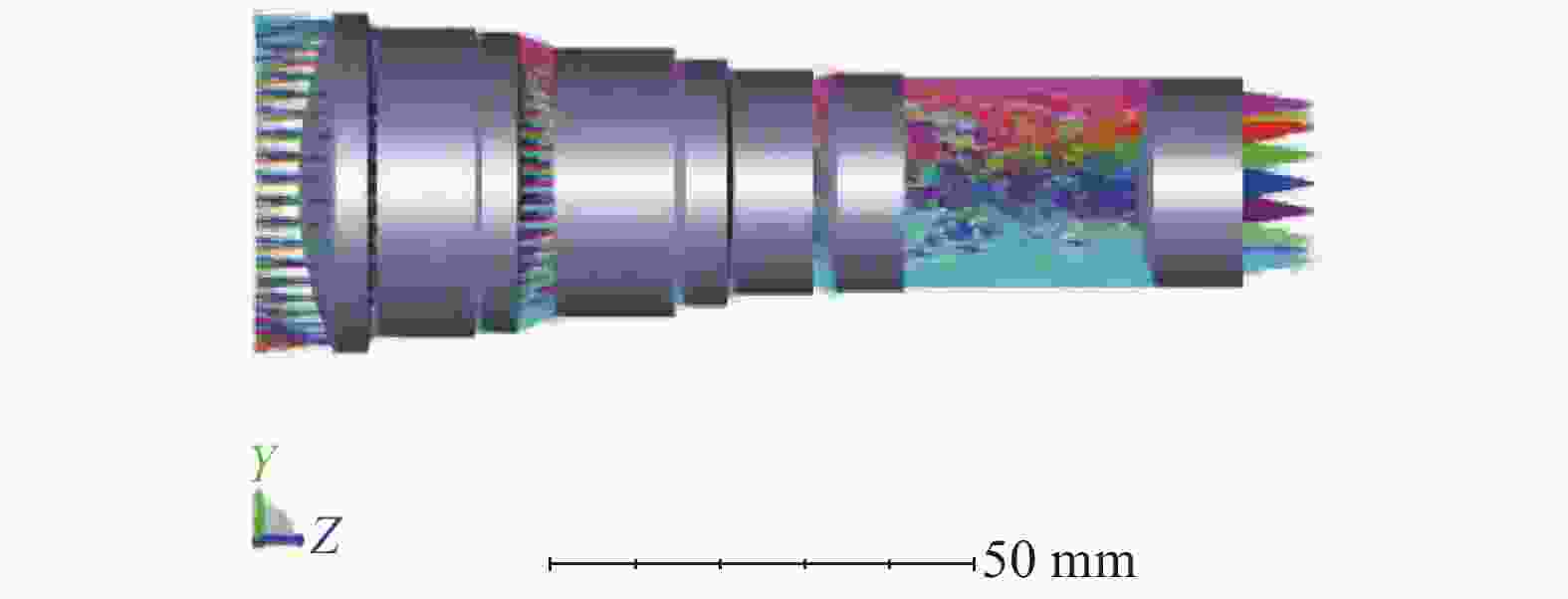


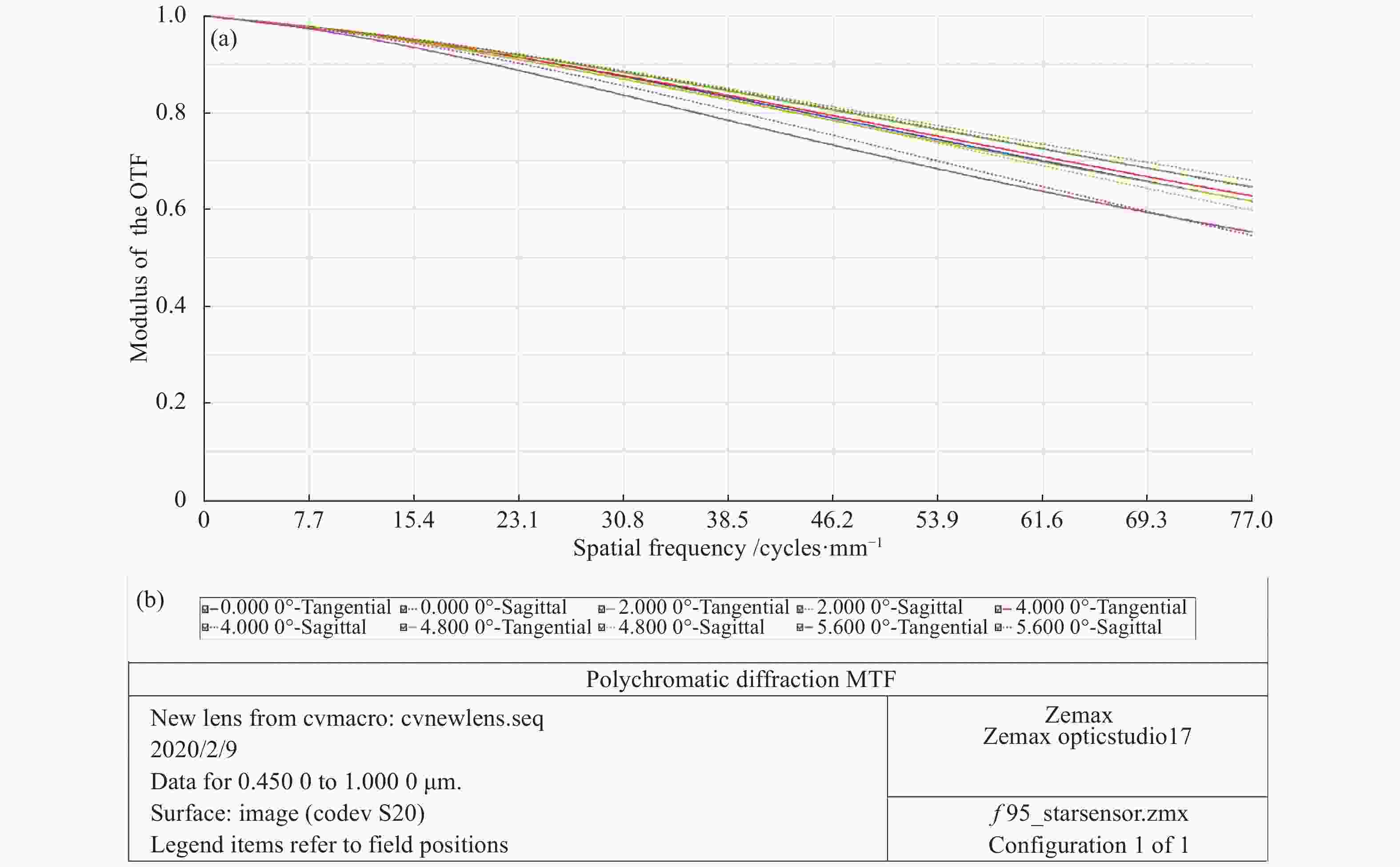






 DownLoad:
DownLoad:

